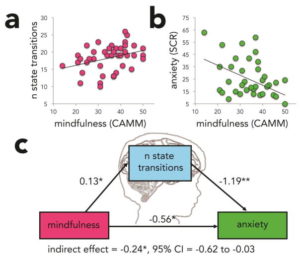Mindfulness is Associated with Changing Neural Connectivity in Children and Adolescents
By John M. de Castro, Ph.D.
“mindfulness meditation training increases resting state connectivity between top-down executive control regions, highlighting an important mechanism through which it reduces stress levels.” Daniel Reed
There has accumulated a large amount of research demonstrating that mindfulness has significant benefits for psychological, physical, and spiritual wellbeing. It even improves high level thinking known as executive function. Its positive effects are so widespread that it is difficult to find any other treatment of any kind with such broad beneficial effects on everything from thinking to mood and happiness to severe mental and physical illnesses. This raises the question of how mindfulness training could produce such widespread and varied benefits. One possibility is that mindfulness practice results in beneficial changes in the nervous system.
The nervous system is a dynamic entity, constantly changing and adapting to the environment. It will change size, activity, and connectivity in response to experience. These changes in the brain are called neuroplasticity. Over the last decade neuroscience has been studying the effects of contemplative practices on the brain and has identified neuroplastic changes in widespread areas. In other words, mindfulness practice appears to mold and change the brain, producing psychological, physical, and spiritual benefits.
The brains of children and adolescents are different from fully mature adult brains. They are dynamically growing and changing. It is unclear how mindfulness affects their maturing brains. In today’s Research News article “Mindfulness and dynamic functional neural connectivity in children and adolescents.” (See summary below or view the full text of the study at: https://www.ncbi.nlm.nih.gov/pmc/articles/PMC5610942/ ), Marusak and colleagues examined the relationship of mindfulness with brain activity in the maturing brain. They recruited children and adolescents aged 7 to 17 years and measured them for mindfulness, anxiety, and depression.
The children and adolescents then had their brains scanned with functional Magnetic Imaging (fMRI). The scans were evaluated for static connectivity, the relatively permanent connections between brain areas, and dynamic connectivity, the changing connections between areas. They looked specifically at 3 systems in the brain, the central executive network, associated with higher level thinking and attention, the salience and emotion network, associate with the importance of stimuli, and the default mode network, associated with mind wandering and self-referential thinking.
They found that mindfulness was associated with better mental health of the children and adolescents with high levels of mindfulness significantly associated with low levels of depression and anxiety. Mindfulness was also significantly associated with the amount of present-moment oriented thinking occurring during the brain scan session. Mindfulness was not associated with static connectivity within the children’s and adolescents’ brains.
With dynamic connectivity on the other hand, they found that mindfulness was associated with greater numbers of transitions between connectivity states. That is, the higher the levels of mindfulness the greater the number of times the connectivity pattern in the brain changed from one set of connections to another. Finally, they also found that the numbers of transitions between connectivity states mediated the association of mindfulness with lower anxiety, such that mindfulness was associated with lower anxiety both with a direct association of mindfulness with lower anxiety and indirectly by higher mindfulness being associated with greater dynamic connectivity which was in turn associated with lower anxiety.
The results suggest that mindfulness is associated with greater brain flexibility in transitioning from different states and this may allow for less anxiety. This suggests that mindfulness allows for greater ability to see things and evaluate what is occurring in different ways and this helps the youths to better appreciate what is happening and thereby lower anxiety. These are incredibly interesting findings that begin to reveal the neural dynamics occurring in children and adolescents that underlie the ability of mindfulness to improve mental health. Mindfulness isn’t associated with different brain connectivity structures in the brains but rather with different abilities to switch around in real time between systems and this improves mental health.
“Just 11 hours of learning a meditation technique induce positive structural changes in brain connectivity by boosting efficiency in a part of the brain that helps a person regulate behavior in accordance with their goals.” – University of Oregon
CMCS – Center for Mindfulness and Contemplative Studies
This and other Contemplative Studies posts are also available on Google+ https://plus.google.com/106784388191201299496/posts and on Twitter @MindfulResearch
Study Summary
Marusak, H. A., Elrahal, F., Peters, C. A., Kundu, P., Lombardo, M. V., Calhoun, V. D., Goldberg, E. K., Cohen, C., Taub, J. W., … Rabinak, C. A. (2017). Mindfulness and dynamic functional neural connectivity in children and adolescents. Behavioural brain research, 336, 211-218.
Abstract
Background
Interventions that promote mindfulness consistently show salutary effects on cognition and emotional wellbeing in adults, and more recently, in children and adolescents. However, we lack understanding of the neurobiological mechanisms underlying mindfulness in youth that should allow for more judicious application of these interventions in clinical and educational settings.
Methods
Using multi-echo multi-band fMRI, we examined dynamic (i.e., time-varying) and conventional static resting-state connectivity between core neurocognitive networks (i.e., salience/emotion, default mode, central executive) in 42 children and adolescents (ages 6–17).
Results
We found that trait mindfulness in youth relates to dynamic but not static resting-state connectivity. Specifically, more mindful youth transitioned more between brain states over the course of the scan, spent overall less time in a certain connectivity state, and showed a state-specific reduction in connectivity between salience/emotion and central executive networks. The number of state transitions mediated the link between higher mindfulness and lower anxiety, providing new insights into potential neural mechanisms underlying benefits of mindfulness on psychological health in youth.
Conclusions
Our results provide new evidence that mindfulness in youth relates to functional neural dynamics and interactions between neurocognitive networks, over time.
https://www.ncbi.nlm.nih.gov/pmc/articles/PMC5610942/
